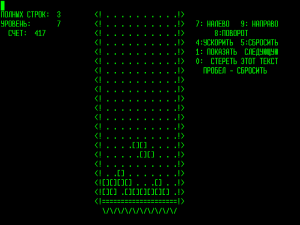
Articles
Editor’s Picks
Game Changing: The Arrival of Tetris in the United States
By Cait Etherington
January 29, 2018
Thirty years ago this week, the arrival of Tetris in the United States made headlines. If Tetris’s debut was newsworthy, it was likely due to Tetris’s Soviet origins. Indeed, Tetris was one of the first Soviet-born products to ever reach U.S. consumers, but Tetris didn’t simply catch the attention of people curious about Soviet products and video-game enthusiasts. Soon after Tetris arrived in America, educators and researchers became fascinated by the tile-matching puzzle game’s potential cognitive benefits. Could Tetris, or games like Tetris, merge entertainment and education. If so, should we actually encourage young people to spend hours playing video games rather than ban them? This debate would prove game changing as it paved the way for the developing of the educational gaming industry.
Tetris in the United States
As legend has it, Tetris was developed by Vadim Gerasimov, an 18-year-old computer science student at Moscow University, and Alexi Paszitnov, an employee at the Computer Center of the USSR Academy of Sciences in Moscow. The game was originally released in June 1984. Wildly popular in the Soviet Union, the game eventually became known to people living well beyond the so-called Iron Curtain. However, as reported in the New York Times on January 29, 1988, the day Tetris was first widely released to consumers in the United States, it was Budapest not Moscow that played a key role in the game’s migration to the West.
Reportedly, Robert Stein, a British entrepreneur, was scouting potential projects at a tech hub in Budapest when he saw someone playing Tetris on a computer. While dismissed by the Hungarian programmers as just a game, Stein saw something with much greater potential. As a result, he went on a mission to track down Tetris’s developers. Eventually Stein licensed the game from a Soviet agency known as Elorg and later licensed his rights to Mirrorsoft, a division of Maxwell Communications, which also happened to be the parent company of Spectrum Holobyte, which eventually released and distributed Tetris in the United States.
Notably, Tetris’ arrival in the United States did result in a few significant updates. As reported in the New York Times on the day of Tetris’s American debut, for the U.S. market, the very basic graphic interface has been replaced with “Colorful graphics that evoke images of the Soviet Union, including an opening scene of a Cessna aircraft buzzing past Red Square.” These features were reportedly added to make Tetris more appealing to what was perceived to be a far more sophisticated group of consumers.
Tetris’s Debut and the Rise of Educational Gaming

Back in 1988, Tetris’s Soviet origins were difficult to ignore. With few products going in or out of the Soviet Union, the game’s arrival in the United States was exceptional on many levels. At the time, there was even no clear indication that Tetris’s programmers, Gerasimov and Paszitnov, would ever profit from the sale of their popular game, since all royalties would go directly to the Soviet Agency known as Elorg. In the end, both programmers did benefit. Following the collapse of the Soviet Union, the developers not only received royalties on the game but also continued to work in computing. Gerasimov eventually moved to the United States to join the MIT Media Lab and later Google while Paszitnov eventually brought his expertise and specific experience in gaming to Microsoft.
Beyond the obvious Soviet-era breakthrough story, Tetris also attracted people’s attention for another reason. As Tetris started to circulate in North America, the game’s addictive nature alarmed some adults while others started to observe Tetris’s potential cognitive benefits, and by the early 1990s, the academic debate about Tetris was in full swing.
While the very earliest Tetris studies tended to adopt Tetris as a tool for cognitive research, soon researchers were also attempting to observe and make a case for the game’s potential cognitive and educational benefits. A 1994 investigation by Lynn Okagaki and Peter A. French, for example, found that “adolescent video game players can accrue some specific cognitive benefits from the time they spend playing video games.” Specifically, the Okagaki and French study found that Tetris had a positive impact on male but not necessarily female players’ spatial visualization.
By 1997, less than a decade after Tetris’s debut in the United States, New York Times technology columnist Steve Lohr published an article optimistically titled, “Computer Pastimes No Longer Viewed as Brain Poison.” The article offered Tetris as just one example among many of videos games that are both addictive and beneficial. But by 1997, Tetris, a simple yet challenging puzzle-game, also had a lot more competition than it did when it arrived in the United States on January 29, 1988. By the late 1990s, action games had placed puzzle games like Tetris largely on the sidelines. However, even as consumer interest in Tetris declined, the game continued to have a loyal following, especially among educators who were increasingly bringing the game into k-12 classrooms.
Tetris’s Other Surprising Benefits
As Tetris begins its fourth decade in the United States, its legacy and impact will no doubt continue to be felt and debated. This is partly due to the fact that the “Tetris effect” continues to be investigated. In addition to its entertainment and educational value, Tetris has recently been embraced as a potential way to treat post traumatic stress disorder (PTSD). In a widely cited 2009 British study, researchers found that trauma flashbacks, which are comprised of sensory-perceptual, visuospatial mental images, might be treated with a sort of “cognitive vaccine.” Their proposed “cognitive vaccine” is Tetris.
Long after Tetris’s debut, what is Tetris’s future? From Soviet-era curiosity to addictive game to source of cognitive research to educational tool to therapeutic intervention, as Tetris reaches middle age, it has already left its mark on the history of gaming and on multiple other fields. In this sense, it is difficult to ignore the impact of the Tetris effect.









One Comment